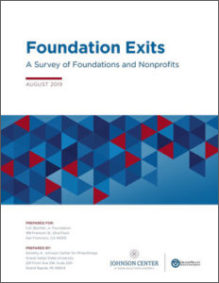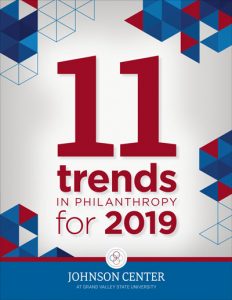Foundations Are No Longer Wedded to the Long Game


 As Teri Behrens writes in this final piece from our 11 Trends in Philanthropy for 2019 report, limited-life foundations and program exits (wherein a foundation closes out a line of work or funding) are becoming increasingly common. Still, this phenomenon is nascent enough that little research into its impact exists.
As Teri Behrens writes in this final piece from our 11 Trends in Philanthropy for 2019 report, limited-life foundations and program exits (wherein a foundation closes out a line of work or funding) are becoming increasingly common. Still, this phenomenon is nascent enough that little research into its impact exists.
In 2018–2019, the Johnson Center collaborated with Independent Sector to field a survey on the experiences and impacts of “foundation exits” for both foundation staff and nonprofit grantees. The findings revealed some common themes that are ripe for further research.
In 2020, we’ll be working with grantors and grantees to hear from practitioners on both sides of the same exit. We look forward to sharing the results of this research with you.
 Since 2010, there has been a significant shift toward creating foundations that have a defined endpoint. According to one estimate (Boris, De Vita, & Gaddy, 2015), about 19 percent of family foundations established between 2010 and 2014 plan to spend out their endowments, compared to only 3 percent of those created before 1970. The United States’ biggest foundation is a limited-life foundation — the Gates Foundation is set to close 20 years after the death of its three trustees, Bill and Melinda Gates and Warren Buffett.
Since 2010, there has been a significant shift toward creating foundations that have a defined endpoint. According to one estimate (Boris, De Vita, & Gaddy, 2015), about 19 percent of family foundations established between 2010 and 2014 plan to spend out their endowments, compared to only 3 percent of those created before 1970. The United States’ biggest foundation is a limited-life foundation — the Gates Foundation is set to close 20 years after the death of its three trustees, Bill and Melinda Gates and Warren Buffett.
Even so, the Center for Effective Philanthropy reports that across different studies they have found that less than 15 percent of CEOs report that their foundation will be limiting its life. Another 19 percent seem to be open to the idea or to learning more information about it.
The reasons for setting up a limited-life foundation vary. For some, the founder wants decisions about funding to be made by people who knew them and understand what they were passionate about. The Ralph C. Wilson, Jr. Foundation is one example of this reasoning. Wilson set up his foundation with a twenty-year lifespan and appointed trustees who were family or long-time business partners. The Edna McConnel Clark Foundation, on the other hand, is choosing to spend down so that they can concentrate their resources and maximize impact.
“Whether spending down or shifting the line of work, these foundations face challenges in both how they engage with partners and how they organize themselves internally.”
Whether spending down or shifting the line of work, these foundations face challenges in both how they engage with partners and how they organize themselves internally. Articles in The Foundation Review Vol. 9, Issue 1 on Foundation Exit Strategies explored some of the issues they confront related to how to leave grantees, communities, and fields of work stronger, rather than creating a hole when they cease operations. Certain grantmaking strategies may be more important as a foundation nears the end; capacity building and general operating support grants and endowment funds may be more frequent. Internal issues related to how to invest the foundation’s corpus, how to retain staff until the end, and how and what to archive are important considerations.

Learn more about limited-life foundations and exit strategies in The Foundation Review Vol. 9, Issue 1. Click here to read the open-access issue online.
Boris, E. T., De Vita, C. J., & Gaddy, M. (2015). Trends in Family Philanthropy. Retrieved from https://www.ncfp.org/knowledge/2015-ncfp-trends-in-family-philanthropy-results-of-the-first-national-benchmark-survey-of-family-foundations/